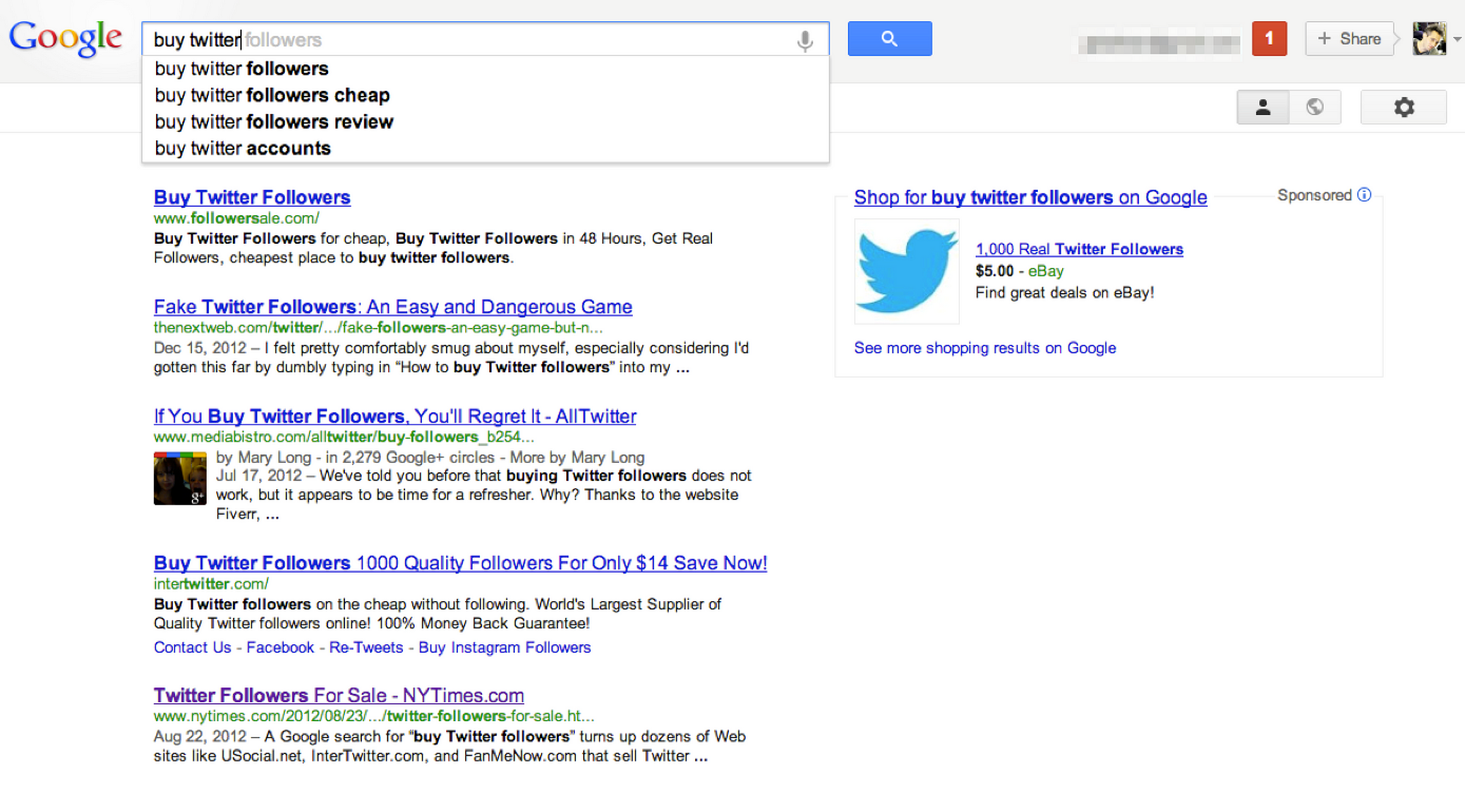BY GILAD LOTAN
Buying your way to status on social networks has become standard practice. From Instagram likes to Twitter followers, there’s a growing number of services that promise to bump up your numbers. (And they’re quite affordable.)
What used to be completely frowned upon, is now, effectively considered an act of social media optimization. Just like choosing the right keywords when optimizing a Google search, can the purchasing of fake followers or likes boost one’s standing in social networks?
That was the main question I set to explore when I decided to take the plunge and buy followers.
***
As a data scientist, I am perpetually working on identifying better ways to rank users and content in social networks. These spaces are filled with what Internet researchers call “status affordances,” the metrics, measures and figures that give us the ability to easily compare one another. Number of fans, favorites, likes or followers?—?these numbers appear everywhere, yet it is unclear how significant or representative of true authority they really are. One thing’s crystal clear: on social media, it is easy to mistake popularity for credibility.
The Experiment
At the start, I used Twitter’s API to get a list of my 2,600 existing Twitter followers. Then I set about figuring out where to buy more.
Google conveniently auto-completed my search for “buy twitter” with a number of useful suggestions, including: “buy twitter followers,” “buy twitter followers cheap,” and “buy twitter followers reviews.” I was certainly not the only one searching for this.

One of the top services that came up was Fiverr, an online marketplace for services that cost five dollars or under. On there, someone offers to record a Morgan Freeman character Voice Over, and another will sing Happy Birthday as Marilyn Monroe all for a bargain price of five bucks. After searching for “twitter followers,” I saw the following list of services each promising a certain amount of “real” or “quality” Twitter followers, ranging from 200 to over 20,000, all for the bargain price of five dollars.
I settled on one that seemed trustworthy.
27,500 followers felt excessive, while 4,000 was a number that I could stomach. I specified my Twitter handle?—?@gilgul?—and ?paid the fee.
And waited.
Within 24 hours, my profile jumped from around 2,600 followers to the 6,600 range. I remember feeling a rush of excitement as I saw notifications fly by showing more and more users following me. Even though I knew this was one hundred percent fake, the thrill excited me, and at the end of the process, having over 6k followers, in all honesty, felt really great.

This is what it looks like when you gain 4000 followers.
Once my 4,000 newly purchased followers were onboard, I used the Twitter API to make another grab of my followers list, which I compared with my earlier list to generate a list of the 4000 fake twitter accounts now following me. This was exciting stuff. In my line of work, having access to such a clean dataset is not easy to come by.
Analysis
Using the data, I began looking more closely at my new followers. It was not immediately clear from glancing at their profiles that they were just bots.

@AnnalisaMonsodz is an example of a typical bot account.
They all had profile images and screen names that didn’t necessarily feel automated. But looking more deeply, it was clear that something was off about their profiles.
The bios included random snippets of text from what I suspected was a book or manuscript. Additionally, the majority of my new fans were following vastly more users than they had users following them.
Now for the exciting part. Using my list of bots, I began to map out who else my new followers followed, hoping to shed light on what kinds of folks purchase followers.
While these fake accounts may be hard to identify just based on profile images or text, by analyzing the network (who they follow and who follows them), everything becomes strikingly clear.
In the aggregate list of hundreds of thousands of accounts my bots followed, I found DJ’s, musicians, fashion designers, comedians, politicians, real estate services, banks, marketers, and brands. It made sense, I suppose. How exciting is a musician with few fans on Twitter? How credible is a politician whose tweets nobody signs up to receive?
But some truly baffled me. One account that clearly acquired followers wass @YellowCabNYC, the “New York City Taxi App.” This is not to be confused with the NYC Taxi & Limousine Commission (@nyctaxi) that regulates yellow taxicabs in the city. Another was @SuperProtein, offering “delicious health and wellbeing supplements,“ as well as @Elisabeth_Musil, a consultant and business coach. The list goes on and on.
Outcome
Even more interesting, at least to me, was what my fake followers did for me. My Klout score almost instantly shot up. I was not impressed by that until I realized that Microsoft’s search engine, Bing, collaborates with Klout, so that a higher Klout score put me higher on Bing’s search results.
My completely fake numbers on one platform had a very real effect on a completely different service.
Over time, I also started seeing an increase in the number of my actual followers. This could be due to the fact that Twitter started pushing out more notifications to their users. It could also be a factor of perceived credibility. When a stranger viewed my profile now, my large number of followers made me look more credible.
After a few months, some of my fake followers began disappearing. But my total number of followers has continued to grow. In a way, what I did was optimize my social media account. Perhaps acquiring that chunk of followers gave me enough of a bump to seed organic growth. User acquisition professionals leverage similar techniques when running paid campaigns, especially within the app store environments.
We’re all used to the practice of Search Engine Optimization (which has become a multi-billion dollar industry). Acquiring status online is just one of the many ways in which someone may perform social media optimization. This is certainly not only happening on Twitter. TagsForLikes is a commonly used service that adds the most popular and relevant hashtags to your Instagram posts, making them much more visible when other users perform searches. Boostlikes boosts your Facebook page’s likes, and various services promise to download your mobile app—some even provide ratings.
 Graph via Google Trends
Graph via Google Trends
The upward slope we see on Google Trends, the growing number of proposed tasks on fiverr.com, and the increasing number articles covering the topic all point to the fact that there’s heightened interest in social media optimization, in gaming the system.
I’m not recommending anyone go out and buy followers. In fact, I can’t get over the feeling that it’s pretty sleazy, but I do believe that acquiring just the right amount, as much as I hate to write it, may have a positive long-term effect on acceleration of growth and visibility.
Gilad Lotan is the chief data scientist at betaworks, a technology company that operates as a studio, building new products, growing companies and seed investing. Previously, Gilad ran the data team at SocialFlow and built data visualizations at Microsoft’s FUSE Labs. Gilad is an advisor for media entities and startups. His work has been covered by the New York Times, the Guardian, Fast Company and the Atlantic Wire and published across a wide range of academic journals. This article was originally featured on Medium and republished with permission.
Photo by whatmegsaid/Flickr (CC BY 2.0)


